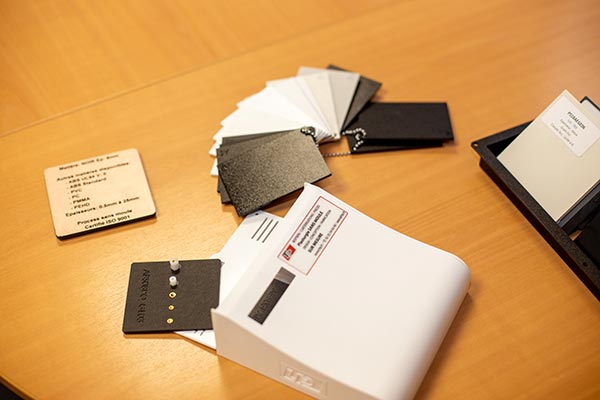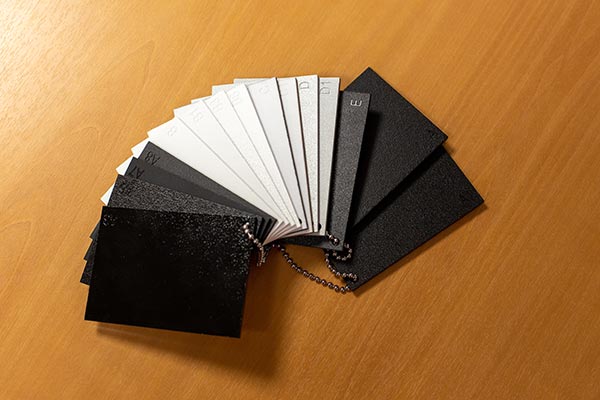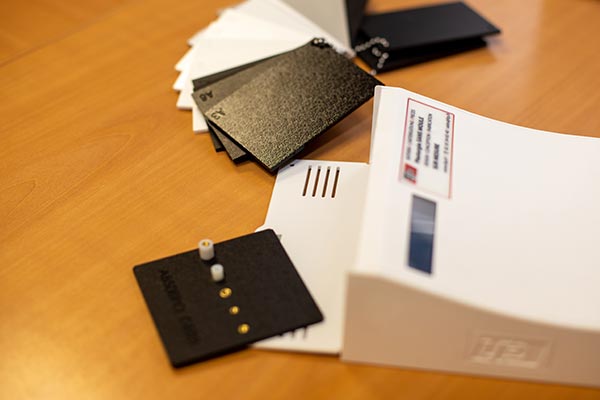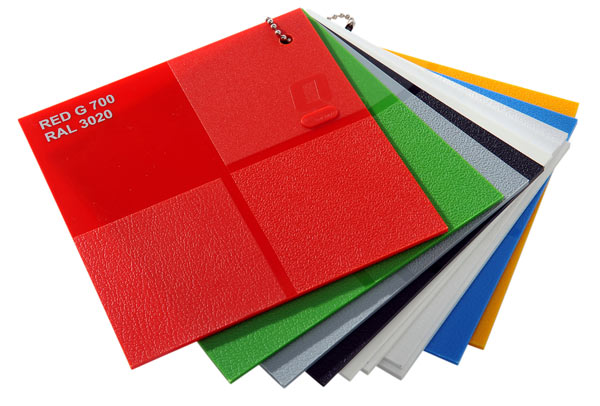- +33 (0)2.35.54.63.40
- sales@ltp.fr
-
La Tôlerie Plastique ZI Route d'Etretat Impasse des thuyas
76930 Octeville-sur-mer France

Plastic casing can meet several requirements. It is important to state explicitly at the beginning of the development phase which standards your final device must meet.
After validation of a technical 3D representing your custom plastic enclosure, LTP manufactures a physical and fully finished prototype to validate the correct understanding of your needs. This prototype allows you to test the assembly of your components and then have your device certified with the plastic casing or the plastic box designed and manufactured by LTP.
In connection with the raw material the following aspects can be influenced:
The raw material used by LTP is plastic sheets. These materials are coloured in the mass, in black, grey or white.
The ‘fine grain’ texture of this material offers greater scratch resistance than a smooth surface.
Thicknesses vary according to product design (3, 4, 6, 8 and 10 mm). If your case is painted, we will choose the background colour that will give the best result. The size of a plate is between 1200x1000mm and 1525x1025mm.
LTP production is a virtually closed cycle, as the offcuts are shredded and returned to the manufacturer of the plastic sheets. Our suppliers of the plastic sheets are renowned and reliable French and European companies.


Without specific constraints the material used is standard ABS or PS. Therefore, electronics embellished, protected or dressed with a standard plastic enclosure, cannot meet requirements such as UL 94 V-0, often requested for medical applications.
ABS plastic enclosure:
Acrylonitrile butadiene styrene (ABS) is a thermoplastic polymer that is impact resistant, relatively rigid, lightweight and mouldable. It belongs to the family of styrenic polymers.
Wikipédia
PS plastic housing:
Polystyrene (PS) is a hard, brittle material that can be coloured. Its mechanical and thermal properties can be modified by adding plasticizers or butadiene (a monomer of polybutadiene) to make a so-called « impact » polystyrene.
Wikipédia
| ABS | PS CHOC (n'est plus sourcée dans la gamme standard) | |
|---|---|---|
| Designation | ACRYLONITRILE-BUTABIENE-STYRENE | POLYSTYRENE SHOCK (not Crystal!) |
| Description | ABS, a thermoplastic used in the manufacture of housings, furniture, decoration and automobiles. ABS, a thermoplastic used in the manufacture of housings, furniture, decoration and automobiles. | PS is a thermoplastic used in the manufacture of housings, furniture, decoration and automobiles. |
| General use | household appliances, toys (LEGO), cars, boats etc. | economical packaging, decorative elements, |
| Mechanical, technical and economic characteristics |
Good scratch resistance due to its grained surface Nice satin appearance Good rigidity and impact resistance Easy to mark Good temperature resistance Environmentally friendly as scraps can be recycled |
Compared to ABS: Less scratch resistance Less satin appearance Less rigidity and impact resistance Easier to mark Less temperature resistance Environmentally friendly as scraps can be recycled |
| Fire resistance | Yes+ (optionnal) | Yes- (optionnal) |
| Impact resistance | Resistance ++ | Resistance + |
| UV resistance | Resistance --- Yellowing : Acrylonitrile Butadiene Styrene is sensitive to the action of UV rays because of the double bonds of the butadiene. |
Resistance +++ Following direct exposure to natural UV light, it can fade in a few months |
| Rigidity | Rigidity ++ | Rigidity + |
| Bonding / Chemical welding | Yes | Yes |
| Bonding / chemical welding characteristics | ABS can be bonded with various solvents. | PS can be bonded with various solvents. |
| Can be glued / welded with : | ABS | PS CHOC |
| Bending | Yes | Yes |
| Galbage | Yes | Yes |
| Chemical resistance | Resistance --- | Resistance --- |
| Electrical characteristics | Insulating +++ | Insulating +++ |
| Use at LTP | The standard material used at LTP for all UL designs included. | Replaced by ABS material on almost all projects. |
| Composition | A thermoplastic copolymer (styrenic polymer family) | An amorphous thermoplastic homopolymer |
| Plastic density | 1.03 - 1.08g/cm3 | 1.04 g/cm3 |
| Density Wood | 0,82g/cm3 | 0,82g/cm3 |
| Density Cardboard | 0,21g/cm3 | 0,21g/cm3 |
| Density Aluminuim | 2,7g/cm3 | 2,7g/cm3 |
| Density Steel | 8,1g/cm3 | 8,1g/cm3 |
| Characteristic for food | White in colour, it can be used in the food industry. | White in colour, it can be used in the food industry. |
| Finishing features | ABS lends itself well to all decorative techniques: painting, printing, metallizing, shielding and electroplating. | PS lends itself well to all decorative techniques: painting, printing, metallizing, shielding and electroplating. |
| Thickness availability | 2 - 3 - 4 - 5 - 6 - 8 - 10mm | 2 - 3 - 4 - 6 mm |
| Colour availability | BLACK / WHITE / GREY | BLACK / WHITE / GREY |
| Minimum temperature | Temp. -30° C | Temp. -30° C |
| Maximum temperature | Temp. + 80°C
Vicat softening point = 102°C |
Temp. + 70°C
Vicat softening point = 87°C |
LTP can offer you specific materials to meet specific needs, such as Flammability, Chemical Resistance, Mechanical Resistance, Food Compatibility, Transparency, or Green Aspect (Recycled, Recyclable, Bio-sourced).
For a transparent effect, we recommend the use of transparent polycarbonate or PMMA. The transparent material can be used for a transparent plastic case or a transparent plastic box, but mostly we use this material to protect your displays, screens or diodes. The range offered is suitable for all uses: clear, clear anti-reflective, clear anti-abrasion, special infrared (better signal transmission), diffusing.

| PVC | PMMA (Plexiglass, Altu, Perspex) | PC (Lexan MR5E, MRX, Makrolon, Impax) | |
|---|---|---|---|
| Designation | Polyvinyl chloride | POLYMETHYL METHACRYLATE | LPOLYCARBONATE |
| Description | Rigid PVC is mainly used for the manufacture of profiles and pipes by extrusion. | PMMA is appreciated for its very good transparency. It is mainly used in the optical, automotive, carpentry and medical sectors. | PC is a thermoplastic used in household appliances, cars, and electronic housings. |
| General use | Panels, signs, displays, window decorations etc. | Optical, carpentry, automotive, medical | Household appliances, automotive, electronic boxes |
| Mechanical, technical and economic characteristics |
Weatherproof chemical and corrosive resistant Low flammability Smooth appearance |
Very good transparency Good UV resistance Remarkable gloss and hardness Available in different types of surface finish (Anti-Reflection, Anti-Ray) PMMA is more economical than PC. There is the possibility of anti-abrasive surface treatment. |
Good impact resistance Good electrical insulation Good temperature resistance Scratch sensitive but more durable than PMMA. PC is less economical than PMMA. There is the possibility of anti-abrasive surface treatment. |
| Fire resistance (UL94V0) | Yes - option | No | Yes - option |
| Impact resistance | Resistance + | Resistance ++ | Resistance +++ |
| UV resistance | Resistance ---
PVC becomes brittle after too much exposure to ultraviolet raysResistance |
Resistance +++
Good resistance to ultraviolet rays |
Resistance +
UV resistant but may yellow slightly over time |
| Rigidity | Rigidity +++ | Rigidity +++ | Rigidity +++ |
| Bonding / Chemical welding | Yes | Yes | Yes |
| Bonding / chemical welding characteristics | PVC is glued with various industrial adhesives. | PMMA can be bonded using various industrial adhesives. | The PC is glued with an industrial adhesive |
| Can be glued / welded with : | PS IMPACT; ABS; PC; PMMA; PVC | PS IMPACT; ABS; PMMA; PVC | PS IMPACT; ABS; PC; PVC |
| Bending | Depending on the projects | Depending on the projects | Depending on the projects |
| Galbage | Yes | No | Depending on the projects |
| Chemical resistance | Resistance +++ | n/a | n/a |
| Electrical characteristics | Insulating +++ | Insulating +++ | Insulating +++ |
| Use at LTP | All LTP designs with chemical resistance requirements EXCEPT all food applications. There is a PVC reference dedicated to food applications "ON DEMAND". PVC cannot be curved and bent. | All designs that require a display to be viewed through a transparent pane. | All LTP designs with specific rigidity requirements and need to meet food standards |
| Composition | 7% sea salt (NaCl) and 43% oil | Thermoplastic of amorphous structure | Thermoplastic of amorphous structure |
| Masse volumique plastique | 1,43g/cm3 | 1.23 g/cm3 | 1,2g/cm3 |
| Plastic density | 0,82g/cm3 | 0,82g/cm3 | 0,82g/cm3 |
| Cardboard density | 0,21g/cm3 | 0,21g/cm3 | 0,21g/cm3 |
| Aluminium density | 2,7g/cm3 | 2,7g/cm3 | 2,7g/cm3 |
| Steel density | 8,1g/cm3 | 8,1g/cm3 | 8,1g/cm3 |
| Characteristics for food | Not suitable for use in foodstuffs | Can be used to present a food display while remaining hygienic | Not suitable for use in foodstuffs |
| Finishing features | LPVC lends itself well to all decorative techniques: painting, printing, metallizing, shielding and electroplating.PVC lends itself well to all decorative techniques: painting, printing, metallizing, shielding and electroplating. | PMMA lends itself well to all decorative techniques: painting, printing, metallizing, shielding and electroplating. | PC lends itself well to all decorative techniques: painting, printing, metallizing, shielding and electroplating. |
| Thickness availability | 1 - 1,5 - 2 - 3 - 4 - 5 - 6 - 8 - 10 - 12 - 15 - 20 - 25mm | 1,5 - 2 - 3 - 4 - 6mm | 0,25 - 0,5 - 1 - 2 - 3 - 4 - 6mm |
| Colour availability | BLACK / WHITE / GREY | TTRANSPARENT / SMOKING / DIFFUSING | BLACK /TRANSPARENT |
| Minimum temperature | Temp. -30° C | Temp. -40° C | Temp. -40° C |
| Maximum temperature | Temp. + 60°C
Vicat softening point = 75°C |
Temp. + 80°C
Vicat softening point = 145°C |
Temp. + 110°C |
At LTP, social and environmental responsibility is in our DNA. Since its creation in 1985, almost all of our offcuts are recycled and reintegrated into the manufacturing cycle of plastic sheets. This is how we are able to offer plastic cases made from recycled material.
Our first search for ORGANIC, GREEN or ECOLOGICAL materials began in the year 2000.
Today, within the framework of our activity, we can offer different types of “GREEN” solutions
Indeed, these terms are often used today without always knowing the « hidden » details behind them. They can define a raw material, a manufacturing process, a distribution channel or even the building and equipment of a company.
Am I being Green or Ecological by making products that are recyclable, with an optimised process in a low energy building, but then sold around the world with a high carbon footprint?
SAm I being Green or Ecological by manufacturing non-recyclable products, with an optimized process in a low energy building, but sold in France and Europe?
Definition of the word « Ecological » :
« Who respect the environment » (LAROUSSE)
As part of this approach, we have developed a range of eco-materials. Indeed, we try to favour composite substances, biodegradable or manufactured from renewable materials and a distribution channel. We also offer references made of resins and vegetable fibres. Their qualities are comparable to those of a classic ABS plastic. But they are less polluting for the environment, which is important for its preservation and sustainable development.
We favour high-performance, technical and resistant materials that allow us to make customised products. But we also innovate by regularly looking for new species to work with. Thus, you have more choice, allowing you to personalise your customised cases even more!
Always listening to our customers, we adapt the raw material according to their technical and aesthetic needs, which are specified in the specifications (checklist) drawn up during the discussion between the technical sales representative and you.
An AGRO composite at LTP is a partly AGRO sourced material (PLA).
Definition :
PLA is a fully biodegradable thermoplastic polymer that uses renewable raw materials. The abbreviation PLA comes from the English word Polylactic Acid, which translates into French as “Acide Polylactique”.
In plastic injection moulding, this material is used for the manufacture of packaging, mainly in the food industry, as a replacement for fossil fuel-based plastics, as it is compatible with food contact.
PLA is used in 3D printing with FDM (wire deposition) technology, and is one of the standard materials in this technology along with ABS. These materials are often compared as the two alternatives available for consumer 3D printers.
(Source : https://www.sculpteo.com/fr/glossaire/pla-definition-fr/)
Give us a call +33(0)2 35 54 63 40.
Let's talk about your project to find the right solution. Our teams are at your service.